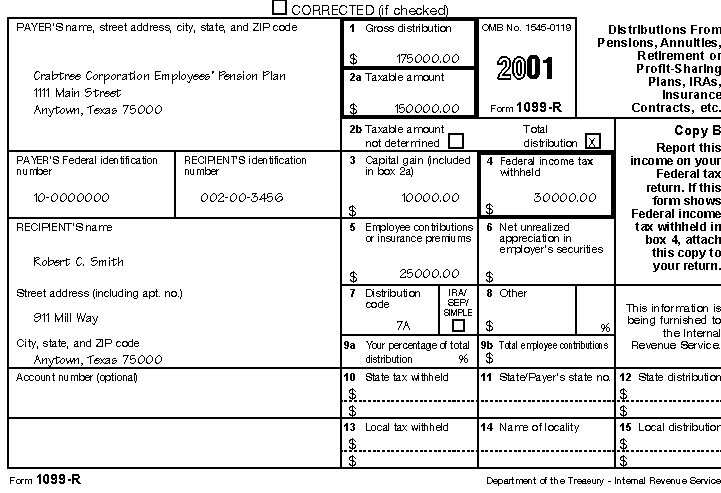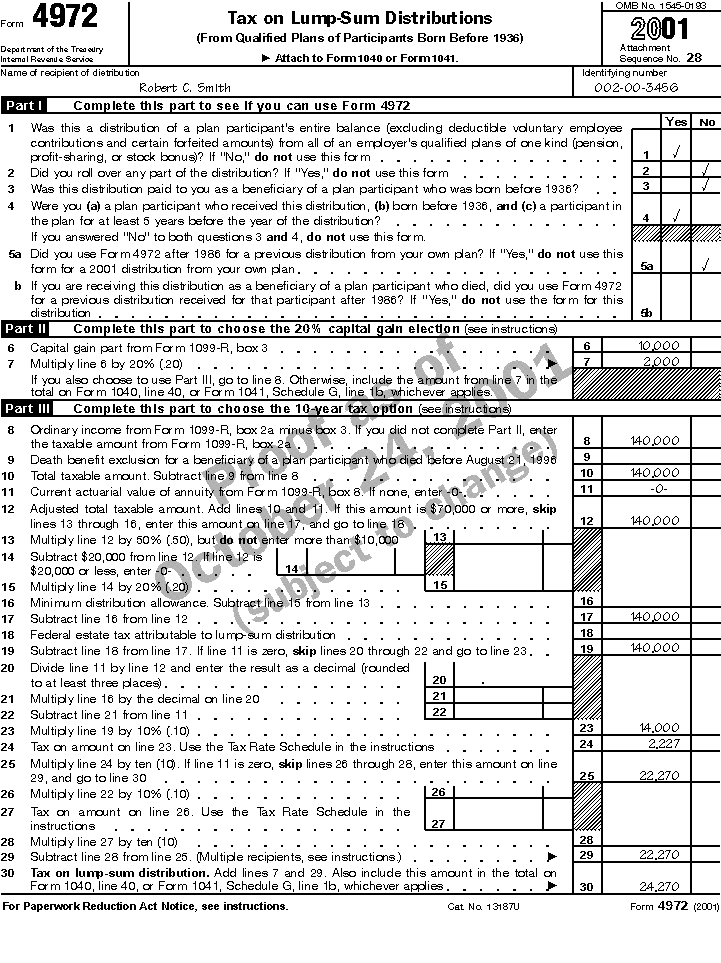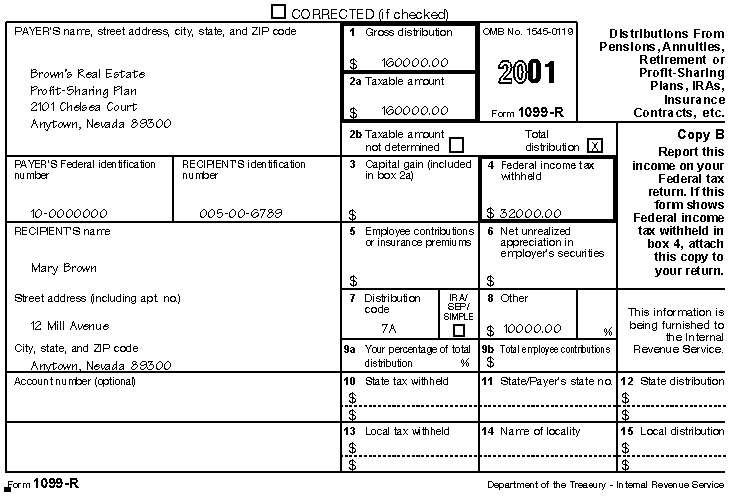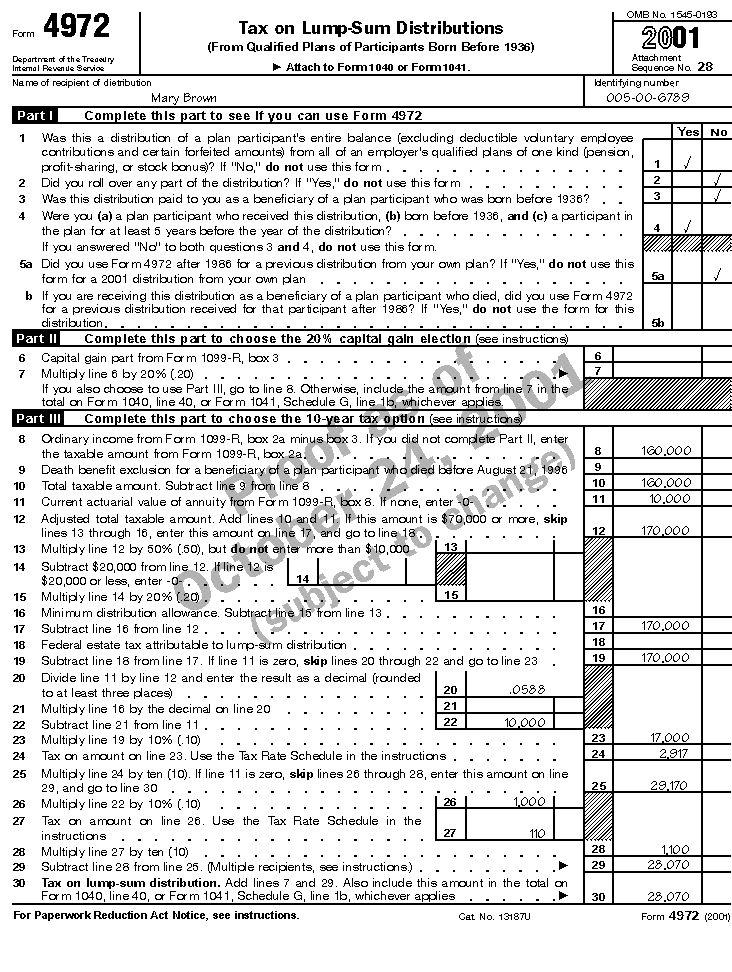Lump-Sum Distributions
If you receive a lump-sum distribution from a qualified employee plan or qualified employee annuity and the plan participant was born before 1936,
you may be able to elect optional methods of figuring the tax on the distribution. The part from active participation in the plan before 1974 may
qualify as capital gain subject to a 20% tax rate. The part from participation after 1973 (and any part from participation before 1974 that you do not
report as capital gain) is ordinary income. You may be able to use the 10-year tax option, discussed later, to figure tax on the ordinary income part.
Each individual, estate, or trust who receives part of a lump-sum distribution on behalf of a plan participant who was born before 1936 can choose
whether to elect the optional methods for the part each received. However, if two or more trusts receive the distribution, the plan participant or the
personal representative of a deceased participant must make the choice.
Use Form 4972, to figure the separate tax on a lump-sum distribution using the optional methods. The tax figured on Form 4972 is added
to the regular tax figured on your other income. This may result in a smaller tax than you would pay by including the taxable amount of the
distribution as ordinary income in figuring your regular tax.
Alternate payee under qualified domestic relations order.
If you receive a distribution as an alternate payee under a qualified domestic relations order (discussed earlier under General
Information), you may be able to choose the optional tax computations for it. You can make this choice for a distribution that would be treated
as a lump-sum distribution had it been received by your spouse or former spouse (the plan participant). However, for this purpose, the balance to your
credit does not include any amount payable to the plan participant.
If you choose an optional tax computation for a distribution received as an alternate payee, this choice will not affect any election for
distributions from your own plan.
More than one recipient.
One or all of the recipients of a lump-sum distribution can use the optional tax computations. See Multiple recipients of a lump-sum
distribution in the instructions for Form 4972.
Lump-sum distribution defined.
A lump-sum distribution is the distribution or payment in 1 tax year of a plan participant's entire balance from all of the employer's qualified
plans of one kind (for example, pension, profit-sharing, or stock bonus plans). A distribution from a nonqualified plan (such as a privately purchased
commercial annuity or a section 457 deferred compensation plan of a state or local government or tax-exempt organization) cannot qualify as a lump-sum
distribution.
The participant's entire balance from a plan does not include certain forfeited amounts. It also does not include any deductible voluntary employee
contributions allowed by the plan after 1981 and before 1987.
Reemployment.
A separated employee's vested percentage in his or her retirement benefit may increase if he or she is rehired by the employer within 5 years
following separation from service. This possibility does not prevent a distribution made before reemployment from qualifying as a lump-sum
distribution. However, if the employee elected an optional method of figuring the tax on the distribution and his or her vested percentage in the
previous retirement benefit increases after reemployment, the employee must recapture the tax saved. This is done by increasing the tax for the year
in which the increase in vesting first occurs.
Distributions that do not qualify.
The following distributions do not qualify as lump-sum distributions for the capital gain treatment or 10-year tax option.
- Any distribution that is partially rolled over to another qualified plan or an IRA.
- Any distribution if an earlier election to use either the 5- or 10-year tax option had been made after 1986 for the same plan participant.
- U.S. Retirement Plan Bonds distributed with a lump sum.
- Any distribution made during the first 5 tax years that the participant was in the plan, unless it was made because the participant died.
- The current actuarial value of any annuity contract included in the lump sum. (The payer's statement should show this amount, which you use
only to figure tax on the ordinary income part of the distribution.)
- Any distribution to a 5% owner that is subject to penalties under section 72(m)(5)(A) of the Internal Revenue Code.
- A distribution from an IRA.
- A distribution from a tax-sheltered annuity (section 403(b) plan).
- A distribution of the redemption proceeds of bonds rolled over tax free to a qualified pension plan, etc., from a qualified bond purchase
plan.
- A distribution from a qualified plan if the participant or his or her surviving spouse previously received an eligible rollover distribution
from the same plan (or another plan of the employer that must be combined with that plan for the lump-sum distribution rules) and the previous
distribution was rolled over tax free to another qualified plan or an IRA.
- A distribution from a qualified plan that received a rollover after 2001 from an IRA (other than a conduit IRA), a governmental section 457
plan, or a section 403(b) tax-sheltered annuity on behalf of the plan participant.
- A distribution from a qualified plan that received a rollover after 2001 from another qualified plan on behalf of that plan participant's
surviving spouse.
- A corrective distribution of excess deferrals, excess contributions, excess aggregate contributions, or excess annual additions.
- A lump-sum credit or payment from the Federal Civil Service Retirement System (or the Federal Employees' Retirement System).
How to treat the distribution.
If you receive a lump-sum distribution, you may have the following options for how you treat the taxable part.
- Report the part of the distribution from participation before 1974 as a capital gain (if you qualify) and the part from participation after
1973 as ordinary income.
- Report the part of the distribution from participation before 1974 as a capital gain (if you qualify) and use the 10-year tax option to
figure the tax on the part from participation after 1973 (if you qualify).
- Use the 10-year tax option to figure the tax on the total taxable amount (if you qualify).
- Roll over all or part of the distribution. See Rollovers, later. No tax is currently due on the part rolled over. Report any part
not rolled over as ordinary income.
- Report the entire taxable part of the distribution as ordinary income on your tax return.
The first three options are explained in the following discussions.
Electing optional lump-sum treatment.
You can choose to use the 10-year tax option or capital gain treatment only once after 1986 for any plan participant. If you make this choice, you
cannot use either of these optional treatments for any future distributions for the participant.
Complete Form 4972
and attach it to your Form 1040 if you choose to use the tax options. If you received more than one lump-sum
distribution for a plan participant during the year, you must add them together in your computation. If you and your spouse are filing a joint return
and you both have received a lump-sum distribution, each of you should complete a separate Form 4972.
Time for choosing.
You must decide to use the tax options before the end of the time, including extensions, for making a claim for credit or refund of tax. This is
usually 3 years after the date the return was filed or 2 years after the date the tax was paid, whichever is later. (Returns filed before their due
date are considered filed on their due date.)
Changing your mind.
You can change your mind and decide not to use the tax options within the time period just discussed. If you change your mind, file Form
1040X, Amended U.S. Individual Income Tax Return, with a statement saying you do not want to use the
optional lump-sum treatment. You must pay any additional tax due to the change with the Form 1040X.
How to report.
If you elect capital gain treatment (but not the 10-year tax option) for a lump-sum distribution, include the ordinary income part of the
distribution on lines 16a and 16b of Form 1040. Enter the capital gain part of the distribution in Part II of Form 4972.
If you elect the 10-year tax option, do not include any part of the distribution on lines 16a or 16b of Form 1040. Report the entire distribution
in Part III of Form 4972 or, if you also elect capital gain treatment, report the capital gain part in Part II and the ordinary income part in Part
III.
Include the tax from line 30 of Form 4972 on line 42 of Form 1040.
Taxable and tax-free parts of the distribution.
The taxable part of a lump-sum distribution is the employer's contributions and income earned on your account. You may recover your cost
in the lump sum and any net unrealized appreciation (NUA) in employer securities tax free.
Cost.
In general, your cost is the total of:
- The plan participant's nondeductible contributions to the plan,
- The plan participant's taxable costs of any life insurance contract distributed,
- Any employer contributions that were taxable to the plan participant, and
- Repayments of any loans that were taxable to the plan participant.
You must reduce this cost by amounts previously distributed tax free.
NUA.
The NUA in employer securities (box 6 of Form 1099-R) received as part of a lump-sum distribution is generally tax free until you sell or
exchange the securities. (See Distributions of employer securities under Figuring the Taxable Amount, earlier.) However, if you
choose to include the NUA in your income for the year of the distribution and there is an amount in box 3 of Form 1099-R, part of the NUA will
qualify for capital gain treatment. Use the NUA Worksheet in the instructions for Form 4972 to find the part that qualifies.
Losses.
You may be able to claim a loss on your return if you receive a lump-sum distribution that is less than the plan participant's cost. You must
receive the distribution entirely in cash or worthless securities. The amount you can claim is the difference between the participant's cost and the
amount of the cash distribution, if any.
To claim the loss, you must itemize deductions on Schedule A (Form 1040). Show the loss as a miscellaneous deduction subject to the
2%-of-adjusted-gross-
income limit.
You cannot claim a loss if you receive securities that are not worthless, even if the total value of the distribution is less than the plan
participant's cost. You recognize gain or loss only when you sell or exchange the securities.
Capital Gain Treatment
Capital gain treatment applies only to the taxable part of a lump-sum distribution resulting from participation in the plan before 1974. The amount
treated as capital gain is taxed at a 20% rate. You can elect this treatment only once for any plan participant, and only if the plan participant was
born before 1936.
Complete Part II of Form 4972 to choose the 20% capital gain election.
Figuring the capital gain and ordinary income parts.
Generally, figure the capital gain and ordinary income parts of a lump-sum distribution by using the following formulas.
|
|
|
|
| Capital Gain: |
|
| |
Total |
|
|
| |
Taxable |
x |
Months of active participation before 1974 |
| |
Amount |
|
Total months of active participation |
| Ordinary Income: |
|
| |
Total |
|
|
| |
Taxable |
x |
Months of active participation after 1973 |
| |
Amount |
|
Total months of active participation |
In figuring the months of active participation before 1974, count as 12 months any part of a calendar year in which the plan participant actively
participated under the plan. For active participation after 1973, count as one month any part of a calendar month in which the participant actively
participated in the plan.
The capital gain part
should be shown in box 3 of Form 1099-R or other statement given to you by the payer of the
distribution.
Reduction for federal estate tax.
If any federal estate tax (discussed under Survivors and Beneficiaries, later) was paid on the lump-sum distribution, you must decrease
the capital gain by the amount of estate tax applicable to it. Follow the Form 4972 instructions for Part II, line 6, to figure the part of the estate
tax applicable to the capital gain and the part applicable to the ordinary income. If you do not make the capital gain election, enter on line 18 of
Part III the estate tax attributable to both parts of the lump-sum distribution. For information on how to figure the estate tax attributable to the
lump-sum distribution, get the instructions for Form 706, United States Estate (and Generation-Skipping Transfer) Tax Return, or contact
the administrator of the decedent's estate.
10-Year Tax Option
The 10-year tax option is a special formula used to figure a separate tax on the ordinary income part of a lump-sum distribution. You pay the tax
only once, for the year in which you receive the distribution, not over the next 10 years. You can elect this treatment only once for any plan
participant, and only if the plan participant was born before 1936.
The ordinary income part of the distribution is the amount shown in box 2a of the Form 1099-R given to you by the payer, minus the amount, if
any, shown in box 3. You can also treat the capital gain part of the distribution (box 3 of Form 1099-R) as ordinary income for the 10-year tax
option if you do not choose capital gain treatment for that part.
Complete Part III of Form 4972 to choose the 10-year tax option. You must use the special tax rates shown in the instructions for Part III to
figure the tax.
Examples
The following examples show how to figure the separate tax on Form 4972.
Example 1.
Robert Smith, who was born in 1933, retired from Crabtree Corporation in 2002. He withdrew the entire amount to his credit from the company's
qualified pension plan. In December 2002, he received a total distribution of $175,000 ($25,000 of employee contributions plus $150,000 of employer
contributions and earnings on all contributions).
The payer gave Robert a Form
1099-R, which shows the capital gain part of the distribution (the part attributable to participation
before 1974) to be $10,000. Robert elects 20% capital gain treatment for this part. A filled-in copy of Robert's Form 1099-R and Form 4972
follows. He enters $10,000 on
Form 4972, Part II, line 6, and $2,000 ($10,000 × 20%) on Part II, line 7.
The ordinary income part of the distribution is $140,000 ($150,000 minus $10,000). Robert elects to figure the tax on this part using the 10-year
tax option. He enters $140,000 on Form 4972, Part III, line 8. Then he completes the rest of Form 4972 and includes the tax of $24,270 in the total on
line 42 of his Form 1040.
Example 2.
Mary Brown, who was born in 1935, sold her business in 2002. She withdrew her entire interest in the qualified profit-sharing plan she had set up
as the sole proprietor.
The cash part of the distribution, $160,000, is all ordinary income and is shown on her
Form 1099-R (see page 22). She chooses to figure the tax on this amount using the 10-year tax option.
Mary also received an annuity contract as part of the distribution from the plan. Box 8, Form 1099-R, shows that the current actuarial value of
the annuity was $10,000. She enters these figures on Form 4972 (see page 23).
After completing Form 4972, she includes the tax of $28,070 in the total on line 42, Form 1040.

Illustrated Form 1099-R for Robert Smith

Page 1 of illustrated Form 4972 for Robert Smith

Illustrated Form 1099-R for Mary Brown

Page 1 of illustrated Form 4972 for Mary Brown
Previous | First | Next
Publication Index | 2002 Tax Help Archives | Tax Help Archives | Home
